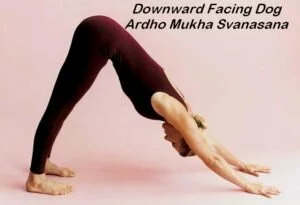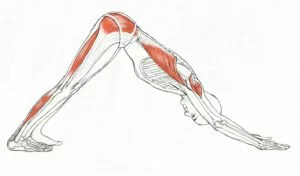 Adho mukha śvānāsana, adho mukha shvanasana (IPA: [əd̪ʱoː mukʰə ɕʋɑːn̪ɑːs̪ən̪ə], ah-doh moo-kah shvah-nah-sah-nah; Sanskrit: अधोमुखश्वानासन; IAST: Adho Mukha Śvānāsana), downward-facing dog Pose, downward dog or down dog is an asana.
Adho mukha śvānāsana, adho mukha shvanasana (IPA: [əd̪ʱoː mukʰə ɕʋɑːn̪ɑːs̪ən̪ə], ah-doh moo-kah shvah-nah-sah-nah; Sanskrit: अधोमुखश्वानासन; IAST: Adho Mukha Śvānāsana), downward-facing dog Pose, downward dog or down dog is an asana.
The name comes from the Sanskrit words adhas (अधस्) meaning ‘down’, mukha (मुख) meaning ‘face’, śvāna (श्वान) meaning ‘dog’ and āsana (आसन) meaning ‘posture’ or ‘seat’
Anatomical focus:-
Primary muscles
Trapezius (traps), latissimus dorsi (lats), triceps, gluteus maximus (glutes), hamstrings, full body/integrated
Secondary muscles (synergists/stabilizers)
Rhomboids, rotator cuff, anterior and medial deltoids (delts), posterior deltoids (delts), extensors, serratus anterior, soleus, gastrocnemius body/integrated
Description:-
The preparatory position is with the hands and knees on the floor, hands under the shoulders, fingers spread wide, knees under the hips and typically about seven inches (17 cm) apart, with the spine straightened and relaxed.
On a deep exhale, the hips are pushed toward the ceiling, the body forming an inverted V-shape. The back is straight with the front ribs tucked in. The legs are straight with the heels reaching to the floor. The hands are open like starfish, keeping the forefinger and thumb pressing down on the floor/mat. The arms are straight, with the inner elbows turning towards the ceiling. If one has the tendency to hyper extend elbows, keeping a microbend to the elbows prevents taking the weight in the joints. Turning the elbows up towards the ceiling will engage the triceps and build strength. The shoulders are wide and relaxed. Line up the ears with the inner arms which keeps the neck lengthened. The hands are shoulder width apart and feet remain hip-width apart. If the hamstrings are very strong or tight, the knees are bent to allow the spine to lengthen fully. The navel is drawn in towards the spine, keeping the core engaged.
The hips move up and back. Focus is on the breath while holding the asana, with deep, steady inhalation and exhalation creating a flow of energy through the body. On an exhale, the practitioner releases onto the hands and knees and rests in balasana.
Benefits:-
BKS Iyengar asserts that this asana stretches the shoulders, legs, spine and whole body; builds strength throughout the body, particularly the arms, legs, and feet; relieves fatigue and rejuvenates the body; improves the immune system, digestion and blood flow to the sinuses, and calms the mind and lifts the spirits.

